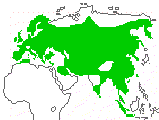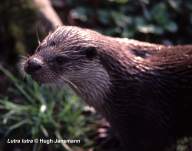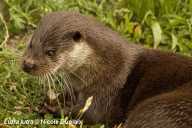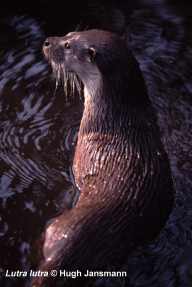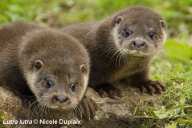 |
Last Update:
Sunday February 22, 2015 |
| •[Home] | [Site Map] | [Contact Us]• | |
| [Home] | [Members] | [News] | [Bulletin] | [Q & A] | [Species] | [Library] |
Lutra lutra (Linnaeus, 1758), the Eurasian Otter (currently being revised)
|
|
DescriptionThe least social of all the otters, the Eurasian Otter is approximately 1m long, and weighing around 8kg, with males being larger and heavier than females. All four paws are webbed and the claws are well-developed as are the teeth. The whiskers are numerous and strong, and used for locating prey. The rhinarium is small, with a W-shaped upper border, and is naked. The fur is more or less dark brown on the back, shading to buff or grey on the belly and throat, with darker subspecies generally found in the north west and paler ones in the south east of the range. White otters are known, and white-spotted otters may be locally common. They mainly eat fish, especially slow-moving, nutrient dense species such as eels and butterfish, but also take water birds, crayfish and frogs. On the Shetland Islands, some otters have been known to abandon fishing in favour of rabbit hunting (Kruuk, 1995). Breeding can occur throughout the year, though locally some seasonality may be seen, correlating to prey density. HabitatEurasian Otters use a wide variety of aquatic habitats. They are found at sea level, and in the Himalayas, and use brackish and salt water as well as fresh water, provided fresh water is available to wash the salt from their coats. They will make use of highland and lowland rivers, streams and lakes, swamps, fens, marshes, ricefields, fjords and coastal areas. In different parts of their range, otters rely on different features of their habitat, but mostly their presence correlates with sufficient food, fresh water and bankside vegetation in which to rest and groom, along with suitable tree roots, earth, rock piles, wood and debris in which to build holts. DistributionThis species is the most widely distributed of all the otters, ranging through Eurasia up to the Arctic Circle, from Ireland to Kamchatka, and south to North Africa, Sri Lanka and Indonesia. Conservation StatusRed List Category Near Threatened, Decreasing The species is recovering in Western Europe (although conservation measures need to be maintained), and viable populations occur in the former USSR. However, past declines and local extinctions in the past, the sensitivity of the species to sudden changes in threat level, the lack of information about huge parts of the range and possible over-exploitation in China and Indo-China justify a precautionary Near Threatened listing. (Source: IUCN Red List) Current ConcernsWater pollution is the major threat to Eurasian Otters, and has caused recent local extinctions from which Western European populations are only now recovering as a result of environmental improvements and focussed conservation efforts. The main dangers are biomagnified dieldrin, DDT/DDE, PCBs and Mercury which affect otter physiology directly, and reduction of food supply due to nitrate-induced eutrophication from agricultural run-off and untreated sewage, and acidification from atmospheric pollutants. Oil spills threaten coastal populations. In parts of the range, illegal hunting is a major issue, and the rise of fish farming has led to conflict, resulting in some countries in licences to kill otters being issued by authorities. Bycatch, especially in eel fykes and crab traps, can be a significant local problem, as can accidental capture in traps and snares, and accidental killing during mink hunts. In Western Europe, road traffic accidents are becoming a major cause of mortality. Leading ResearchersJim Conroy, Dilian G. Georgiev, George Gorgadze, A. Kranz, Lionel Lafontaine, David MacDonald, S.M. Macdonald, C.F. Mason, Laurent Mercier, K. Roche, Jordi Ruiz-Olmo, Uolevi Skarén, Paul Yoxon Key PublicationsGeneral
Distribution
Ecology
Threats and Conservation
Useful Links |
| [Copyright � 2006 - 2011 IUCN OSG] | [Home] | [Site Map] | [Contact Us] |

